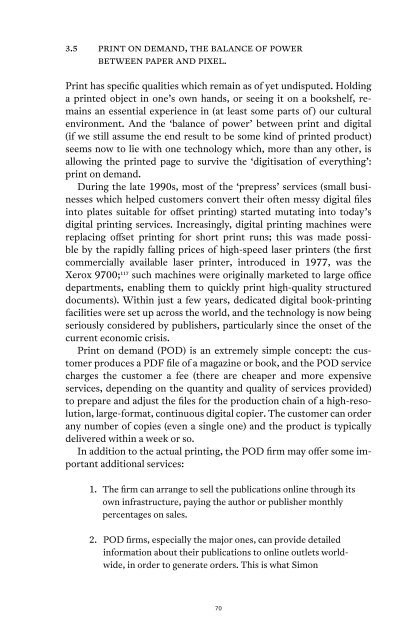Post- Digital Print - Monoskop
Post- Digital Print - Monoskop
Post- Digital Print - Monoskop
Create successful ePaper yourself
Turn your PDF publications into a flip-book with our unique Google optimized e-Paper software.
3.5 print on demand, the balance of power<br />
between paper and pixel.<br />
<strong>Print</strong> has specific qualities which remain as of yet undisputed. Holding<br />
a printed object in one’s own hands, or seeing it on a bookshelf, remains<br />
an essential experience in (at least some parts of ) our cultural<br />
environment. And the ‘balance of power’ between print and digital<br />
(if we still assume the end result to be some kind of printed product)<br />
seems now to lie with one technology which, more than any other, is<br />
allowing the printed page to survive the ‘digitisation of everything’:<br />
print on demand.<br />
During the late 1990s, most of the ‘prepress’ services (small businesses<br />
which helped customers convert their often messy digital files<br />
into plates suitable for offset printing) started mutating into today’s<br />
digital printing services. Increasingly, digital printing machines were<br />
replacing offset printing for short print runs; this was made possible<br />
by the rapidly falling prices of high-speed laser printers (the first<br />
commercially available laser printer, introduced in 1977, was the<br />
Xerox 9700; 117 such machines were originally marketed to large office<br />
departments, enabling them to quickly print high-quality structured<br />
documents). Within just a few years, dedicated digital book-printing<br />
facilities were set up across the world, and the technology is now being<br />
seriously considered by publishers, particularly since the onset of the<br />
current economic crisis.<br />
<strong>Print</strong> on demand (POD) is an extremely simple concept: the customer<br />
produces a PDF file of a magazine or book, and the POD service<br />
charges the customer a fee (there are cheaper and more expensive<br />
services, depending on the quantity and quality of services provided)<br />
to prepare and adjust the files for the production chain of a high-resolution,<br />
large-format, continuous digital copier. The customer can order<br />
any number of copies (even a single one) and the product is typically<br />
delivered within a week or so.<br />
In addition to the actual printing, the POD firm may offer some important<br />
additional services:<br />
1. The firm can arrange to sell the publications online through its<br />
own infrastructure, paying the author or publisher monthly<br />
percentages on sales.<br />
2. POD firms, especially the major ones, can provide detailed<br />
information about their publications to online outlets worldwide,<br />
in order to generate orders. This is what Simon<br />
70

















